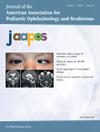下斜退行手术治疗单侧先天性上斜肌麻痹的临床特点比较分析。
IF 1.2
4区 医学
Q3 OPHTHALMOLOGY
引用次数: 0
摘要
目的:评价单侧先天性上斜肌麻痹(SOP)患者下斜肌麻痹后的三个临床特征(原发性凝视、头部倾斜和眼底外伸)的变化。方法:我们回顾性分析了2020年至2023年在我中心接受下斜肌衰退治疗的单侧先天性SOP患者的医疗记录。如果患者有弱视、主视远视>20Δ、双侧SOP、因头部创伤、神经系统原因、脑血管疾病或斜视手术史获得性SOP,则排除。分析术前和术后的主要凝视、头部倾斜和眼底外翻的测量结果,并计算术后改善的百分比。分析结果与术后改善程度之间的相关性。结果:共纳入81例患者。术前平均斜视11.6Δ,头部倾斜15.1°,眼底外倾11.0°。术后随访15.4个月。斜视术后平均改善率为77%,头部倾斜为58%,眼底外翻为75%。远视和眼底挤压的改善显著相关(R2 = 0.403, P < 0.001);然而,斜视和头部倾斜(R2 = 0.0011, P = 0.36)和头部倾斜和敲诈(R2 = 2.190, P = 0.967)的改善无显著相关。结论:与头倾斜相比,原发性凝视和眼底屈伸的改善更明显,且改善程度有显著相关性。本文章由计算机程序翻译,如有差异,请以英文原文为准。
Comparative analysis of clinical features following inferior oblique recession surgery for unilateral congenital superior oblique palsy
Purpose
To assess changes in three clinical features (hypertropia in primary gaze, head tilt, and fundus extorsion) following inferior oblique recessions in patients with unilateral congenital superior oblique palsy (SOP).
Methods
We retrospectively reviewed medical records of patients with unilateral congenital SOP who underwent inferior oblique recession at our center between 2020 and 2023. Patients were excluded if they had amblyopia, hypertropia >20Δ in primary gaze, bilateral SOP, acquired SOP due to head trauma, neurological causes, or cerebrovascular diseases, or a history of previous strabismus surgery. The pre- and postoperative measurements of hypertropia in primary gaze, head tilt, and fundus extorsion were analyzed, and postoperative improvement was calculated as the percentage reduction from the preoperative value. Correlations between outcomes with regard to the amount of postoperative improvement were analyzed.
Results
A total of 81 patients were included. Mean preoperative hypertropia was 11.6Δ, head tilt was 15.1°, and fundus extorsion was 11.0°. The postoperative follow-up period was 15.4 months. The average amount of postoperative improvement was 77% for hypertropia, 58% for head tilt, and 75% for fundus extorsion. Improvements in hypertropia and fundus extorsion were significantly correlated (R2 = 0.403, P < 0.001); however, improvements in hypertropia and head tilt (R2 = 0.0011, P = 0.36) and head tilt and extorsion (R2 = 2.190, P = 0.967) were not significantly correlated.
Conclusions
Hypertropia in primary gaze and fundus extorsion improved more than head tilt, and the improvements were significantly correlated.
求助全文
通过发布文献求助,成功后即可免费获取论文全文。
去求助
来源期刊

Journal of Aapos
医学-小儿科
CiteScore
2.40
自引率
12.50%
发文量
159
审稿时长
55 days
期刊介绍:
Journal of AAPOS presents expert information on children''s eye diseases and on strabismus as it affects all age groups. Major articles by leading experts in the field cover clinical and investigative studies, treatments, case reports, surgical techniques, descriptions of instrumentation, current concept reviews, and new diagnostic techniques. The Journal is the official publication of the American Association for Pediatric Ophthalmology and Strabismus.
 求助内容:
求助内容: 应助结果提醒方式:
应助结果提醒方式:


